Essential Kitesurf Accessories for Every Enthusiast
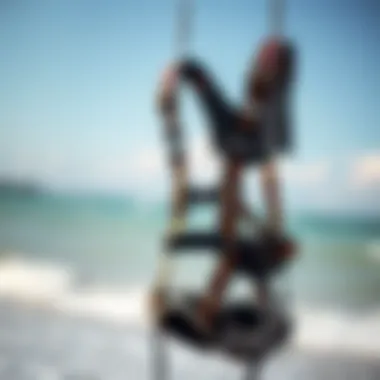
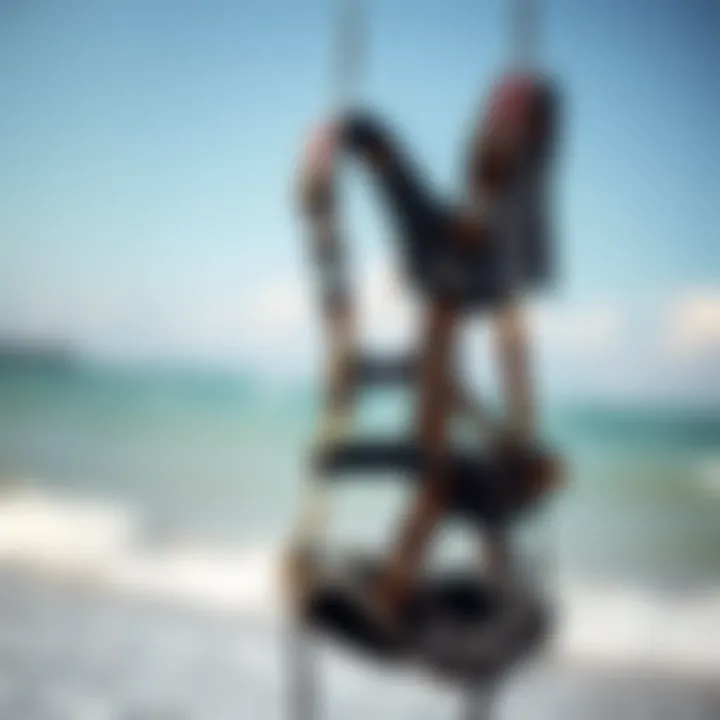
Intro
Kitesurfing is an exhilarating sport that combines elements of surfing, windsurfing, and paragliding. But while the thrill of riding the waves is undeniable, having the right accessories makes all the difference. Understanding kitesurf accessories not only ensures safety but also enhances performance on the water. Let’s take a closer look at what makes up the comprehensive world of kitesurfing gear.
Gear Selection
When it comes to kitesurfing, having the right gear isn’t just a recommendation; it's a necessity. The following sections will delve into the key components of kitesurfing gear, ensuring that you're well-equipped to conquer the elements.
Types of Kites
First up are kites themselves. There are mainly three types of kites used in kitesurfing:
- C-Kites: Known for their high performance and power, these kites are perfect for experienced riders looking to maximize speed and tricks.
- Bow Kites: These kites feature a unique design that allows for better wind range and stability, ideal for beginners and those who seek an enjoyable ride without too much drama.
- Delta Kites: Combining aspects of both C and Bow kites, Delta kites offer versatility and ease of use, making them suitable for a wide array of skill levels.
Each type offers its own set of characteristics. Selecting the right kite requires an understanding of local wind conditions, personal skill level, and desired riding style. For those just starting out, it's advisable to consult with experienced kiteboarders or instructors. They can provide insights into suitable options based on your specific needs.
Choosing the Right Board
While kites catch the wind, boards ensure riders stay afloat. Boards can generally be categorized into:
- Directional Boards: Best for surfers looking to manipulate waves, these boards are akin to surfboards and prioritize performance in choppy water.
- Twin-Tip Boards: The most common choice for recreational kitesurfers, twin-tip boards are symmetrical, making them suitable for beginners due to their versatility in riding direction.
Choosing the correct board involves understanding personal preferences in riding style and comfort in maneuverability. It's essential to consider weight and foot size as well; a well-fitted board can make navigating the surf a seamless experience.
"The gear you choose can make or break your experience in kitesurfing. Always prioritize quality over quantity."
If you’d like to dive deeper into material and design specifics, resources like Wikipedia can be a great starting point (Wikipedia Kitesurfing).
Skill Development
Acquiring the right gear is just half the game. Skill development plays an equally crucial role in becoming a proficient kitesurfer. Here, we will discuss techniques and tips to enhance your abilities on the water.
Essential Techniques
Developing core techniques is essential for success in kitesurfing. One of the first is the water start, which involves getting onto the board and standing up while the kite provides lift. Working on controlling the kite while balancing on the board is crucial for stability.
Progression Tips
As you grow more comfortable in your kitesurfing journey, push your boundaries with new challenges. Progression does not mean taking wild leaps; rather, it's about incremental improvements. Set realistic goals such as mastering jumps or trying new tricks like the backroll, ensuring safety remains your top priority.
By staying informed on the latest advancements in techniques and gear maintenance, you can guarantee not only a better performance but also a longer lifespan for your equipment.
In the expanding arena of kitesurfing accessories, knowledge is power. By immersing yourself in the details of gear and honing your skills thoughtfully, you’ll elevate your experience and find more joy in every ride.
Preface to Kitesurf Accessories
Kitesurfing, a thrilling blend of surfing, windsurfing, and paragliding, is not just about gliding across the water with the wind at your back. The experience can be significantly enhanced or hampered by the accessories an individual chooses to utilize. In this context, the term "kitesurf accessories" encompasses a range of essential items, from safety gear and performance-enhancing tools to maintenance and storage solutions.
Understanding the importance of these accessories is paramount for both novice and experienced kiteboarders alike. They can significantly impact not only the effectiveness of one’s kitesurfing performance but also enhance or diminish safety on the water. Accessories like impact vests, helmets, and safety leashes contribute directly to one's overall risk management strategy during a session. Missing these components could mean the difference between a rewarding outing and a discouraging experience.
When selecting kitesurf accessories, enthusiasts should not overlook varied factors that contribute to their effectiveness and reliability:
- Compatibility with current gear: Not every item works seamlessly with others, and recognizing these connections is crucial.
- Quality of materials: High-quality accessories not only ensure durability but can also affect performance under duress.
- Personal fit and comfort: An item may look great but if it doesn’t fit well or feels uncomfortable, it can become a distraction.
Ultimately, being well-versed in kitesurf accessories is essential. As the sport evolves, so does the technology behind these tools. From the latest advancements in harnesses designed for maximum mobility to GPS devices that track performance metrics, staying informed allows the kiteboarding community to improve each ride in both safety and enjoyment.
"The right kitesurf accessories are like the unsung heroes of the water – when you have them, you ride with confidence; when you don't, the experience can quickly turn turbulent."
In the ensuing sections, we shall delve deep into the various types of kitesurf accessories, exploring their functions and significance. This knowledge will equip enthusiasts and instructors alike, ensuring that every kitesurfing session is as thrilling and safe as possible.
Importance of Kitesurf Accessories
The role of kitesurf accessories cannot be overstated in the realm of this exhilarating sport. As a kitesurfer, whether a seasoned pro or a fresh-faced enthusiast, the right gear can mean the difference between a thrilling glide above the waves and a regrettable mishap. Safety, performance, and overall enjoyment hinge on the accessories you choose.
Safety First
One of the most significant reasons for investing in quality kitesurf accessories is safety. Accidents can happen on the water, and having the appropriate gear can minimize risks. Helmets are a prime example. They protect your head from potential impacts, whether from crashing your board or an unexpected wave. Likewise, impact vests offer cushioning and support during falls, reducing injuries that might otherwise spoil a day on the water.
Enhancing Performance
Beyond safety, kitesurf accessories enhance performance. The right control bar can provide better handling, as it directly influences your kite's response to inputs. In turn, this can lead to improved maneuverability and a more enjoyable ride. Performance accessories, like high-quality kite leashes and footstraps, can make a significant difference in how effectively a kitesurfer interacts with the kite and board. Accessories designed for performance aren’t just a luxury; they are a necessity to unlock one’s full potential in this thrilling sport.
Comfort and Convenience
Comfort also comes into play with kitesurf accessories. A well-fitted harness allows for optimal weight distribution, which in turn helps maintain endurance over longer sessions on the water. Wetsuits and rash guards are not just protective; they also add an element of comfort against cold water and friction. Therefore, selecting accessories that address both functionality and comfort is crucial when considering your gear.
Community and Eco-Conscious Choices
As the kitesurfing community grows, so do the number of eco-conscious options available. Choosing accessories made from sustainable materials can lessen the environmental impact of our beloved sport. As kitesurfers, being mindful of our choices is paramount, not only for our safety and performance but also for the health of the waters we ride on.
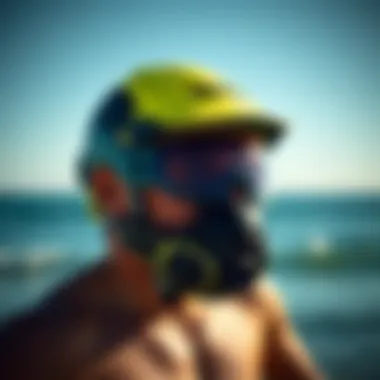
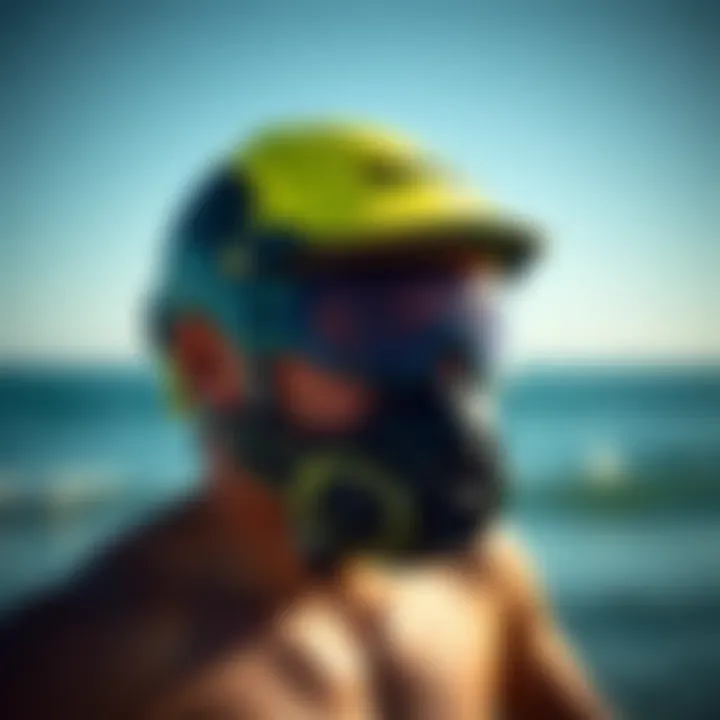
"The right accessory doesn't just complement your kitesurfing experience; it transforms it."
Epilogue
In essence, the importance of kitesurf accessories boils down to three key elements: safety, performance, and comfort. As every seasoned kitesurfer will tell you, it’s not just about the kite and board; it’s about the intricate web of accessories that ensures a thrilling, yet safe ride. Each piece contributes in its own way to creating a seamless experience for enthusiasts and professionals alike. As this sport continues to evolve, so too do the accessories that support it, pushing boundaries and blazing trails for kitesurfers around the globe.
Safety Gear Essentials
Safety gear is not just a checkbox on a list; it’s the lifeline for anyone kitesurfing. It provides a necessary layer of protection against potential hazards on the water. This aspect of kitesurfing combines personal safety and performance, which makes it paramount. The right safety equipment can mean the difference between a fun day out and a trip to the hospital. Every kitesurfer should prioritize protective gear as they take to the waves, ensuring that their adventures are enjoyable and safe.
Helmets
Types of helmets
Helmets come in several varieties, each catering to different aspects of kitesurfing. Some designs focus solely on impact protection, while others integrate buoyancy for added safety on the water. A prominent choice among freestylers is the hard-shell helmet, known for its robust construction and ability to withstand significant hits. This piece of gear acts like a fort on your head, protecting you from unexpected falls or collisions. However, it can be a bit heavier on the noggin compared to softer alternatives, which might bother some riders.
Fit and comfort considerations
When it comes to helmets, achieving the perfect fit is crucial. A helmet that doesn’t fit well might slide around or fall off during sudden movements, which can defeat its purpose. Look for features like adjustable straps and inner padding that conforms to your head. The right helmet should feel snug but not pinching. Comfort increases the likelihood of wearing it consistently, thus keeping safety front and center every time you hit the surf. Consider helmets with ventilation as well; they help keep your head cooler in hot weather, making long sessions more pleasant.
Alternative safety measures
Besides a sturdy helmet, kitesurfers might explore alternative safety measures such as using inflatable vests or additional padding gear. While these accessories might not be conventional, they can offer extra protection for your body, particularly your ribs and spine. Notably, inflatable vests can provide both flotation and warmth, making them particularly appealing in colder waters. Having completed safety options amplifies your safety net, ensuring that you’re not just relying on one piece of equipment.
Impact Vests
Material and design variations
Impact vests are another significant piece of safety gear. These vests often boast a blend of materials, such as neoprene and foam, designed to absorb shocks during use. Different vests suit various water conditions; for instance, a thicker vest might make sense on rough waves, whereas a lighter model could be ideal for calm waters. The design plays a crucial part too, often varying in terms of cut and thickness across different brands. A properly selected vest will not only keep you safe but also enhance your range of motion, allowing for agile maneuvers in the air.
Functionality in different conditions
Impact vests vary in functionality depending on weather and water conditions. On choppy days, wearing a vest that helps absorb impact from potential falls is crucial. Some designs even feature additional flotation material, which can provide a little boost to keep you buoyant in rough waters. This functionality might seem like an additional cost, but considering the alternative—injuries from falls—it’s a smart investment in your safety.
Harnesses
Types of harnesses
Harnesses can be categorized mainly into seat harnesses and waist harnesses. A seat harness sits lower on the body, distributing pull pressure more evenly across the waist and legs, which many find more comfortable, especially during long rides. On the flip side, a waist harness allows for greater flexibility and is often preferred by skilled riders who pull off advanced tricks. Choosing the right type of harness depends on personal preferences and the style of kitesurfing you engage in.
Choosing the right harness size
Getting the size right on your harness is essential. An ill-fitting harness can lead to chafing or, worse, compromise your safety if it comes loose during riding. Consult sizing charts provided by manufacturers and measure your waist accurately. An adjustable harness will accommodate your body changes over time, ensuring a snug fit no matter what. Finding that balance between fit and comfort will enhance your performance and prevent distractions.
Connection systems and their importance
Connection systems link your harness to the kite lines. They play a pivotal role in safety and control. Most harnesses utilize a quick-release system, which ensures that you can detach from the kite quickly in emergencies. A well-designed connection reduces the risk of untimely releases and increases your ability to manage the kite effectively. Investing in a harness with reliable connection mechanics means you’re setting yourself up for more enjoyable and worry-free rides.
Performance Accessories
Performance accessories play a pivotal role in enhancing both the effectiveness and enjoyment of kitesurfing. They provide the necessary tools that allow riders to optimize their experience, helping them to master the waves or engage in captivating tricks. By investing in such gear, one not only amplifies performance but also boosts confidence when tackling varying wind and water conditions. Key elements within performance accessories include kite leashes, control bars, and footstraps that cater to different styles and skill levels.
Kite Leashes
Leash types
When it comes to kite leashes, the variety available makes it essential to choose rightly. Common types include standard leashes, which are generally attached to the harness, and quick-release options for emergencies. The standard leashes typically boast a simple design that offers reliability in regular conditions, while quick-release leashes provide peace of mind during unexpected incidents. Given that safety is paramount in kitesurfing, having a quick-release leash can be beneficial, allowing a kiteboarder to detach easily from their gear
Length considerations
Length plays a significant role in how kite leashes function. Standard lengths usually hover around 20 inches, depending on individual preferences and surfing styles. Shorter leashes might provide better control in turbulent waters but limit mobility, whereas longer leashes can enhance freedom but add a risk of tangling. Therefore, the right length must be balanced between comfort and practical usability on the water.
Safety features
Safety features are a major consideration when selecting kite leashes. Leashes that include spiral cords, for instance, help prevent snagging in challenging situations. Some leashes are even designed with intelligent safety mechanisms that allow them to break away under a certain tension. This aspect becomes crucial in avoiding accidents. Keeping a sharp focus on such features can help ensure increased safety for kitesurfers.
Control Bars
Bar sizes and materials
Control bars come in various sizes and are constructed from multiple materials. Most commonly, fiberglass, aluminum, and carbon fiber are utilized, each offering unique benefits. For instance, a larger control bar can deliver better leverage for a more powerful kite, while smaller bars tend to provide more agility. Understanding the interplay between bar size and material can dramatically impact the responsiveness of your kite and overall control.
Safety systems incorporated
Safety systems built into control bars are critical to mitigating risks while kitesurfing. Features like depower systems or emergency release mechanisms contribute significantly to enhanced safety. These systems are designed to simplify handling when faced with unexpected situations on the water. Choosing a control bar imbued with robust safety systems is therefore a sensible decision for any kitesurfer.
Adjustability features
The adjustability of control bars is another key characteristic. Such features allow users to tailor their gear to specific riding styles or conditions. Many modern bars include adjustable width settings, making them versatile for all types of riders. This not only improves comfort but can also lead to better control, making it an asset on the water.
Footstraps and Bindings
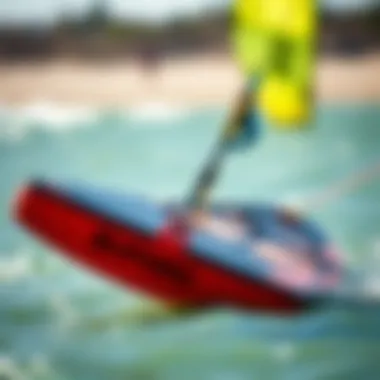
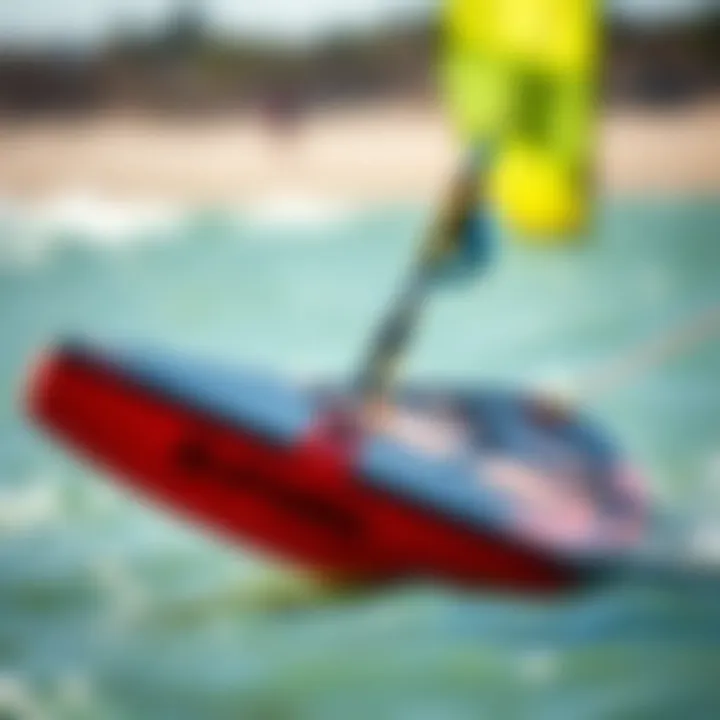
Differences in design
Footstraps and bindings come in varied designs tailored for different riding styles and preferences. For instance, some footstraps feature a traditional open design, allowing easy entry and exit, while others have newer adjustable versions that ensure a snug fit. These differences can impact how secure one feels during intense maneuvers in the water, making it vital to select straps that align with individual comfort levels.
Comfort versus performance trade-offs
Kiteboarders often find themselves weighing comfort against performance when choosing footstraps. Generally, softer straps provide better comfort, especially during long sessions, while stiffer options may offer superior control during impactful performances. Balancing these requirements becomes essential for achieving optimal performance, particularly for advanced tricks or in turbulent waters.
Wind and Water Gear
Wind and water gear is absolutely essential when kitesurfing. This equipment not only keeps you comfortable and protected while out on the waves but also enhances your overall performance on the water. Kitesurfing is heavily influenced by environmental factors like temperature and water conditions. Therefore, having the right gear that supports your interaction with these elements is crucial. Poor choices can lead to discomfort or, even worse, safety hazards.
Wetsuits and Rash Guards
Material types
When it comes to wetsuits and rash guards, the material plays an important role in performance. Generally, most wetsuits are made of neoprene, a synthetic rubber that provides insulation and flexibility. Neoprene is popular because it traps a layer of water between the suit and the skin, which warms up due to body heat. Alternatively, rash guards are usually made from lightweight materials like polyester or nylon that offer UV protection and prevent chafing.
One of the unique features of neoprene is its buoyancy, which offers an additional layer of safety in water. However, it can be less durable against sharp objects like barnacles or corals. Choice of material therefore hinges on whether one prioritizes warmth or agility.
Thickness for different conditions
Thickness of wetsuits is an often overlooked element that can significantly affect your experience on the water. Different thicknesses cater to varying water temperatures. For instance, in warmer waters, a 2mm wetsuit may suffice, while colder conditions may require a 4mm or even 6mm wetsuit for adequate insulation.
One important aspect of thickness is flexibility. Thinner suits allow greater movement, which is essential for kitesurfing tricks or quick turns. On the flip side, thicker suits provide better insulation, so you won’t feel the chill even when submerged. Thus, your choice of suit thickness should depend on your kitesurfing destination and water temperature.
Durability concerns
Durability is a key consideration when investing in wetsuits and rash guards. The harsh aquatic environment can wear down gear faster than one might expect. A well-constructed wetsuit typically uses high-quality stitching and materials that can withstand abrasions.
A unique feature of advanced wetsuits is reinforced areas, particularly around the knees and elbows, which are prone to damage. However, even the most robust wetsuits have a shelf life, and wear and tear can lead to leaks, resulting in a cold and uncomfortable session. Regular inspections, especially after a few months of use, can help in spotting early signs of damage, helping you avoid catastrophic failures while riding.
Boots and Shoes
Grip and support features
Footwear is another area that greatly influences comfort and performance. Good diving boots and shoes for kitesurfing should provide solid grip and stability. Many kitesurfing shoes come with rubber soles designed to maximize traction on surfboards and sandy beaches.
These grip features enable kitesurfers to move freely without worrying about slipping, enhancing overall control. Additionally, supportive footwear often includes padded insoles, which can reduce fatigue over long sessions. However, over-supportive footwear might restrict natural foot movement, something that could prove detrimental if you are performing tricks.
Size and fit considerations
Size and fit of boots and shoes are other key aspects in enjoying a kitesurfing experience. A snug fit is essential to avoid slippage, which may lead to instability. However, if the shoe is too tight, it could restrict blood circulation, causing discomfort or even numbness during your session.
It’s often a good idea to try them on and walk around a bit before purchase. Some brands even offer custom sizing options for that exact fit. Remember, a perfect fit can enhance not just comfort, but also your performance on the kiteboard. An optimal combination of size, fit, and features will ensure that you can concentrate on your skills on the water instead of adjusting your gear frequently.
Maintenance Tools
In the world of kitesurfing, maintenance tools form the backbone of keeping your gear in optimal condition. Just like a chef needs their knives sharp, a kiteboarder must be equipped with the right tools to ensure their setup is running smoothly. Ignoring maintenance leads to poor performance and can potentially turn a fun outing into a disaster. To maximize your kitesurfing experience, understanding and using the right maintenance tools is paramount.
Repair Kits
Common kit components
A well-stocked repair kit is a kiteboarder's safety net. The typical components of a repair kit can include adhesive patches, a multi-tool, assorted screws, and even a pump adapter. One of the standout features of these kits is the self-adhesive patches, which can save the day after an unexpected tear or puncture.
These materials are crafted to be durable and water-resistant, making them an excellent choice for emergency repairs. Not only are they handy, but they also allow for fast fixes, letting you get back on the water quickly. However, one might find that these patches often lack the long-term durability of more permanent solutions, so they should be seen as stop-gaps rather than fixes.
Usage tips for quick fixes
Knowing how to effectively use your repair kit is as important as the kit itself. One crucial tip is to always clean the area around the damaged part before applying any patches. This ensures good adhesion and increases the likelihood of a successful repair.
Another option is to carry a small pump in your kit. If you find your kite sagging mid-session, a quick pump can make all the difference in your performance. The convenience of having these tools on hand allows for immediate action, but keep in mind that frequent usage may prompt a proper repair to be necessary later on.
Storage Solutions
Transport bags
Transporting your kitesurfing gear can be a hassle without the right bags. Quality transport bags provide a sturdy solution to keep your kite, board, and other accessories safe during travel. Look for bags with ample padding and multiple compartments for organized packing. The waterproof feature is also a key characteristic since it protects your equipment from unforeseen weather during transit.
Choosing the right transport bag significantly contributes to prolonging the lifespan of your gear, reducing the wear and tear that can occur while moving from place to place. However, be cautious as some bags can be bulky, making them less convenient for tight spaces.
Drying and storing tips
Proper drying and storage of kitesurf gear directly influence its longevity. After a session, it is essential to dry your kite thoroughly before packing it away. Lay it flat in a shaded area to avoid sun damage.
Additionally, storing your gear in a cool, dry place helps prevent mold and mildew from taking hold, which can be detrimental over time. These strategies are not just practical; they also cultivate a good habit that ensures your gear remains in prime condition. However, neglecting this process can lead to serious damage, cutting short your next session before it even begins.
"An ounce of prevention is worth a pound of cure."
Taking the time to maintain and properly store your gear will pay off, both in performance and longevity.
Technological Innovations
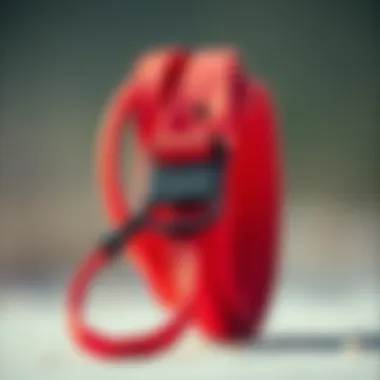
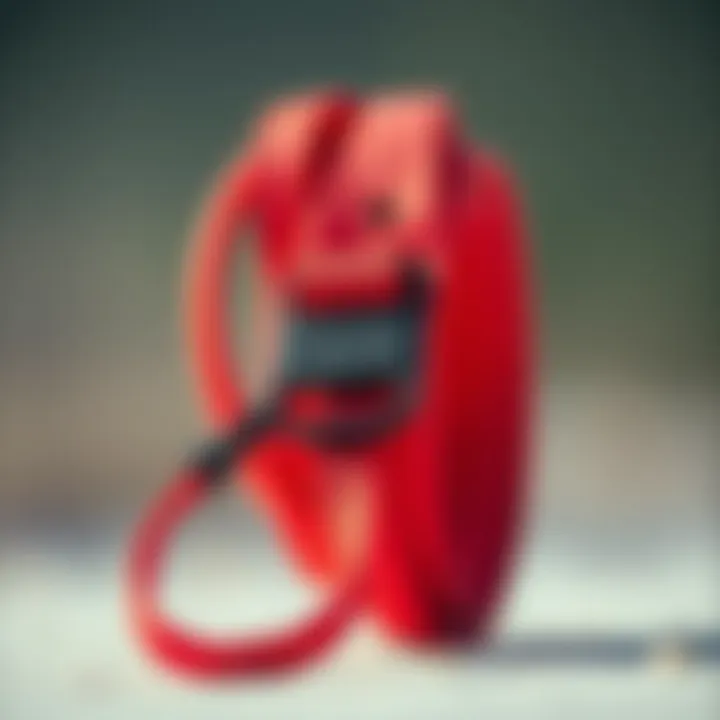
In the realm of kitesurfing, technological innovations are not just trends; they are essential elements that can shape the entire riding experience. As the sport evolves, various new gadgets and tools emerge, enhancing performance and safety. The critical takeaway here is that these innovations can significantly influence how kiteboarders interact with their environment and equipment, enabling them to push the limits further than before.
GPS Devices
Tracking performance metrics
Tracking performance metrics has emerged as a cornerstone for kitesurfers seeking to optimize their skills. With the help of GPS devices, riders can monitor real-time data such as speed, distance traveled, and airtime, giving them a detailed picture of their performance throughout a session. This technology provides insights into areas needing improvement, allowing kiteboarders to analyze their moves more effectively.
Such metrics can be a game changer, as they not only help in personal growth but also foster competition among friends and within the community. A standout feature is the ability to share these metrics instantly via apps, creating a virtual camaraderie that can motivate riders to improve.
"Kiteboarding is not just about the thrill; it's about constantly getting better, and GPS tracking brings that journey to life."
However, knowing how to interpret performance data can be a double-edged sword. While it offers great advantages in structuring your training, overreliance on statistics might overshadow the joy of simply riding the waves.
Choosing the right device
When it comes to choosing the right device, understanding the features offered is crucial. The market is flooded with options ranging from budget-friendly trackers to high-tech devices packed with features like heart rate monitoring and weather updates. A key characteristic of these devices is their usability; they should be intuitive enough for every skill level, from newbies to seasoned pros.
The most notable aspect of these devices is their durability—after all, they need to withstand saltwater, sand, and the occasional splash. Riders should look for waterproof and robust designs that can handle the rigors of kitesurfing.
The downside, however, comes with choosing a device that's too complex or has features that go unused. A more straightforward device may suffice for those just looking to track their rides without diving into heavy analytics.
Camera Accessories
Mounting options
For kiteboarders, mounting options for cameras are a key consideration in capturing breathtaking footage. Various mounts allow photographers and videographers to attach cameras at different angles on their kites or boards. This flexibility lets riders showcase their styles and skills from unique perspectives, which can be particularly appealing on social media platforms.
An essential benefit of diverse mounting options is the ability to experiment. Riders can choose between helmet mounts for a first-person viewpoint or kite mounts to catch sweeping panoramic shots that capture the entirety of their environment. Each offers a distinctive storytelling angle, making the footage more engaging.
On the flip side, a poorly constructed mount can lead to frustrating and shaky footage, undermining the quality of what could have been stunning shots. So, riders must prioritize secure and reliable mounts while considering their filming preferences.
Best practices for capturing footage
To truly highlight the beauty of kitesurfing, following best practices for capturing footage is crucial. Some fundamental tips include framing the shot correctly, paying attention to lighting, and filming during peak conditions when winds and waves create the most dramatic scenes.
One key characteristic of these best practices is planning: knowing what moments to capture, whether it's an impressive move or breathtaking scenery. Capture wide shots when launching, and close-ups during trick execution. This strategic approach creates a visually engaging narrative for the viewers.
Additionally, it's wise to check battery life and storage before hitting the water, as missing out on capturing an incredible moment due to technical glitches can be disheartening. However, overly focusing on the technicality of filming can detract from the experience itself—strike a balance between documenting the ride and enjoying it.
Environmental Considerations
The topic of environmental considerations in kitesurfing accessories is nothing short of pivotal. As kiteboarding rapidly grows in popularity, it becomes increasingly essential to acknowledge and mitigate its impact on nature. The beach environment, fragile ecosystems, and marine life face numerous risks from discarded gear, where plastics and synthetics can pose significant threats. Hence, embracing eco-friendly options is not merely a trend; it's a responsibility that both individuals and companies should shoulder. This section highlights the nuances and significance of selecting environmentally conscious gear and the benefits that arise from such choices.
Eco-Friendly Gear Options
In the world of kitesurfing, eco-friendly gear options are drawing more attention than ever. This isn't just about following a fleeting fad; it’s a sustainable approach to enjoying the sport we love while protecting the environments we cherish. Let’s explore the materials used in sustainable gear and the implications of choosing biodegradable options.
Materials used in sustainable gear
When we talk about materials used in sustainable gear, we're diving deep into the various fabrics and composites that have a lesser impact on the environment. For instance, many manufacturers are turning to recycled plastics and organic cotton. Recycled polyester is a prominent choice because it diverts waste from landfills and reduces the demand for new materials, making it both eco-friendly and durable.
One key characteristic of these materials is their biocompatibility, which means they break down more readily at the end of their lifecycle. This unique feature outweighs traditional materials that persist in the environment for centuries. Picking gear made from these sustainable materials can significantly reduce the ecological footprint associated with kitesurfing.
However, there are still some drawbacks to consider. The durability of eco-friendly materials might not always match that of their conventional counterparts, leading to a need for more frequent replacements, which could counter their initial benefits. Therefore, understanding the long-term impacts and weighing them against immediate desires is imperative.
Impact of biodegradable options
On to the impact of biodegradable options, these choices are crucial when it comes to minimizing waste. Biodegradable gear is designed to break down into natural substances when disposed of, thus avoiding the harmful accumulation of synthetic materials in landfills and oceans. A noteworthy characteristic is their decomposition properties, which allow them to naturally return to the environment without leaving toxic residues.
This type of gear is gaining traction because it marries performance with sustainability. 🌊 For example, kiteboards incorporating biodegradable elements provide the same high-level performance expected while also ensuring that they leave little to no environmental footprint once they are at the end of their lifecycle.
Nevertheless, some biodegradable options can come with higher price tags, limiting accessibility for all kiteboarders. Balancing the cost against environmental benefits is an aspect every rider must consider when shopping for gear. Choosing biodegradable equipment signifies a commitment to our oceans and shorelines, ensuring they remain pristine for future generations.
"The environmental impact of our choices extends beyond the immediate. It is a ripple effect that touches everything that comes in contact with our waters and lands."
In summary, as kiteboarders, instructors, and event organizers, embracing eco-friendly and biodegradable options plays a critical role in fostering a sustainable relationship with our environment. By opting for materials that prioritize ecological health, everyone's commitment to the sport and its natural surroundings can be significantly enhanced.
End
Summarizing the various aspects of kitesurf accessories is essential, particularly for both novice and seasoned kiteboarders. Understanding each accessory's role not only enhances your experience but can also make the difference in safety and performance on the water. This guide has discussed the importance of each category of gear, emphasizing how they interplay under different conditions and scenarios.
Key Considerations
In the world of kitesurfing, the significance of appropriate gear cannot be brushed aside.
- Safety first: The right safety gear can protect you from potential risks associated with kitesurfing. Helmets, impact vests, and harnesses serve not just as accessories but as critical components in ensuring your wellbeing during sessions.
- Performance boost: Performance accessories like control bars and footstraps are crucial for maneuverability and comfort. They directly correlate to skill development and enjoyment on the water. Choosing equipment that aligns with your riding style can result in a more fulfilling experience.
- Tech-savvy tools: As technology in kitesurfing evolves, incorporating devices like GPS trackers and camera systems becomes increasingly relevant for both performance assessment and capturing memories.
- Eco-conscious choices: As the environment is increasingly at the forefront of many conversations, opting for eco-friendly gear not only helps the planet but also resonates with the principles of the kitesurfing community.
"The best gear is the one that complements your style, keeps you safe, and respects the environment."
This guide aims to be more than just an informative piece; it's a resource that encourages kiteboarders to approach their sport thoughtfully. By arming yourself with knowledge, you become a more competent rider, able to make decisions that optimize safety and fun.
Closing Thoughts
For more insights, consider exploring related discussions on platforms like Reddit and relevant educational resources that delve deeper into kitesurf accessories.
Whether you're a participant in events or simply hitting the waves, being informed about kitesurf accessories can elevate your overall kiting experience.















